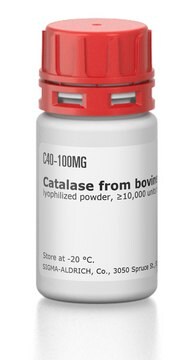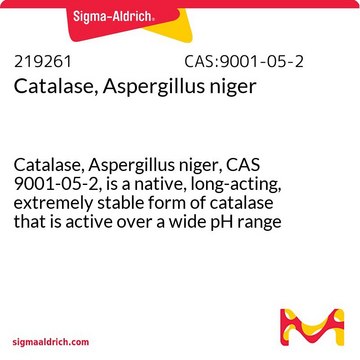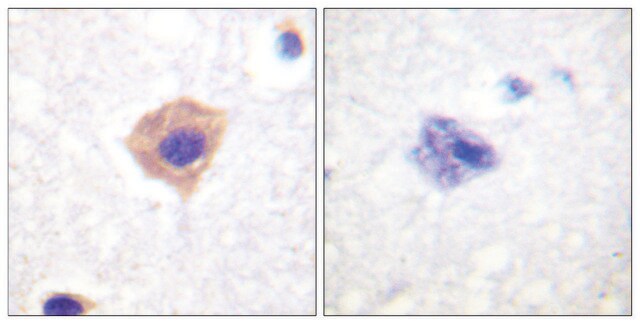02071
Catalase from Corynebacterium glutamicum
solution, deep brown, ≥500000 U/mL
Faça loginpara ver os preços organizacionais e de contrato
About This Item
Número CAS:
Número MDL:
Código UNSPSC:
12352204
NACRES:
NA.54
Produtos recomendados
fonte biológica
bacterial (Corynebacterium glutamicum)
Formulário
solution
concentração
≥500000 U/mL
cor
deep brown
Condições de expedição
wet ice
temperatura de armazenamento
2-8°C
cadeia de caracteres SMILES
O(CC)C(=O)c1ccc(cc1)O
InChI
1S/C9H10O3/c1-2-12-9(11)7-3-5-8(10)6-4-7/h3-6,10H,2H2,1H3
chave InChI
NUVBSKCKDOMJSU-UHFFFAOYSA-N
Descrição geral
Catalase is ubiquitously found in animals, plants, fungi, and humans. It is made up of looped polypeptide chains that are arranged as tetramers or dimers and a core, that contains iron or manganese ions. Catalase can be differentiated into two types such as heme-containing (type I), which possesses an iron-porphyrin cofactor and a non-heme-containing (type II), which possesses a dinuclear manganese active site.
Aplicação
Catalase from Corynebacterium glutamicum has been used to identify and characterize purified bacterial peptide (PPBP) produced from Bacillus thuringiensis. It has also been used to study its inhibition by nitric oxide.
Ações bioquímicas/fisiológicas
Catalase is an antioxidant enzyme that plays a role in alleviating oxidative stress by the removal of hydrogen peroxide to produce oxygen and water. Lower levels of catalase lead to several age-related disorders including hypertension, anemia, vitiligo, Parkinson′s disease, Alzheimer′s disease, schizophrenia, bipolar disorders, diabetes mellitus, and cancer.
Definição da unidade
1 U corresponds to the amount of enzyme which decomposes 1 μmol H2O2 per minute at pH 7.0 and 25°C
forma física
contains ~30% glycerol, 10% ethanol
Outras notas
The purity of this product is not determined. It is tested and sold by activity rather than mass.
Palavra indicadora
Warning
Frases de perigo
Declarações de precaução
Classificações de perigo
Flam. Liq. 3
Código de classe de armazenamento
3 - Flammable liquids
Classe de risco de água (WGK)
WGK 1
Ponto de fulgor (°F)
105.8 °F - closed cup
Ponto de fulgor (°C)
41 °C - closed cup
Equipamento de proteção individual
Eyeshields, Faceshields, Gloves, type ABEK (EN14387) respirator filter
Escolha uma das versões mais recentes:
Já possui este produto?
Encontre a documentação dos produtos que você adquiriu recentemente na biblioteca de documentos.
Os clientes também visualizaram
Nitin Kumar et al.
Science advances, 4(10), eaat7779-eaat7779 (2018-10-20)
Active materials are capable of converting free energy into directional motion, giving rise to notable dynamical phenomena. Developing a general understanding of their structure in relation to the underlying nonequilibrium physics would provide a route toward control of their dynamic
Angela Sacchi et al.
Environmental pollution (Barking, Essex : 1987), 177, 82-89 (2013-03-12)
Coastal lagoons are constantly subjected to releases of chemical pollutants, and so organisms may be exposed to such toxicants. This study investigated through a multivariate approach the physiological status of bivalve Ruditapes philippinarum, farmed in Sacca di Goro lagoon. Biomarkers
L V Barabash
Klinicheskaia laboratornaia diagnostika, (12)(12), 14-17 (2013-03-14)
The technique of cosinor-analysis was applied to study the oncological dynamics of hormonal and lipid status, activity of peroxide oxidation of lipids in 580 healthy males and females residing in the Western Siberia. The clear circannual rhythm of gluco-corticoid function
Zh P Kopteva et al.
Mikrobiolohichnyi zhurnal (Kiev, Ukraine : 1993), 75(1), 41-47 (2013-03-23)
Lipolytic and catalase activity of Pseudomonas pseudoalcaligenes 109, Rhodococcus erythropolis 102, Bacillus subtilis 138 and their association with different growth models: biofilm and plankton ones. It is shown that under biofilm conditions the fermentative activity of bacteria under study was
Milka O Montes et al.
International journal of phytoremediation, 15(2), 168-187 (2013-03-16)
Hexavalent chromium is a contaminant highly mobile in the environment that is toxic for plants at low concentrations. In this work, the physiological response of Convolvulus arvensis and Medicago truncatula plants to Cr(VI) treatments was compared. C. arvensis is a
Nossa equipe de cientistas tem experiência em todas as áreas de pesquisa, incluindo Life Sciences, ciência de materiais, síntese química, cromatografia, química analítica e muitas outras.
Entre em contato com a assistência técnica














